What lawyers earn in 2019
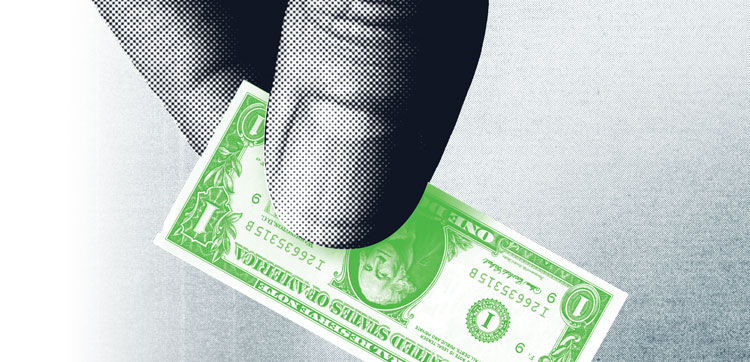
Photo by YinYang/E+
In the decade since the Great Recession, wages for private lawyers have risen, with the average salary now at $144,230. However, digging deeper into a collection of data released in the last year-and-a-half shows the wealth is not being shared equally across gender, region, client type and practice areas.
“There’s a fair bit of income inequality—that is not unique to the legal profession. At the very top of the profession, people are extremely well-compensated,” says Jon Lindsey, a partner at Major, Lindsey & Africa. “There’s lots of lawyers who aren’t at big firms, who aren’t partners, who aren’t rainmakers, who are making a fraction of what those folks are making. It depends on where you are in the scheme of things.”
The big winners—as in other areas of the U.S. economy—are those already winning, according to the ABA Profile of the Legal Profession, released at the ABA Annual Meeting in San Francisco in August.
With hubs for technology and media, California hosts four of the top 10 highest lawyer wage-earning metro areas: Silicon Valley and San Francisco—ranking first ($207,950) and second ($183,070)—and Los Angeles and the Ventura area—ranking fourth ($176,020) and sixth ($172,900). The Washington, D.C., metropolitan area, which includes parts of Maryland, Virginia and West Virginia, is third at $179,980.
This data, compiled by the Bureau of Labor Statistics and released in May 2018, only includes wages and excludes self-employed attorneys as well as compensation in the forms of bonuses or profit-sharing, which affects equity partners.
In the middle of the top 10 is Houston, where many firms base their energy practices and attorneys pull down $175,380 on average.
America’s financial center, New York City, and its bedroom community, Stamford, Connecticut, find themselves at seventh and eighth place, respectively, where attorneys earn on average $172,000 a year.
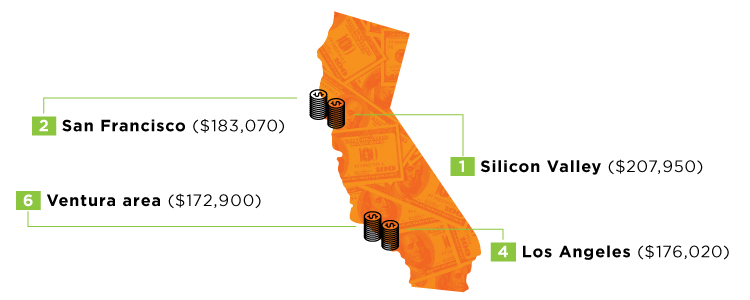
Photos by Cimmerian/E+; illustration by LAUDISENO/iStock/Getty Images Plus
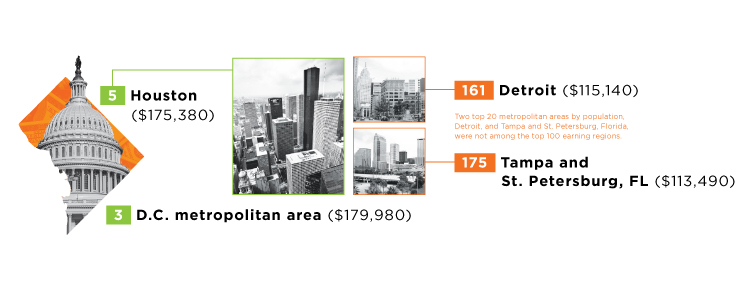
Photos by TylerFairbank/iStock/Getty Images Plus, MoreISO/iStock/Getty Images Plus, Marko Horvat/iStock/Getty Images Plus, pawel.gaul/iStock/Getty Images Plus, illustrations by bgblue/DigitalVision Vectors,
BLS data reflects a rolling average, meaning the data is not a snapshot of May 2018 but an average among six datasets going back to November 2015. Due to this approach, more recent trends may not be fully reflected in the data.
While the overall national picture might seem rosy for many, the data reveals pockets of haves and have-nots. While annual mean wages top out in Silicon Valley at $207,950, lawyers in Arecibo, Puerto Rico, a community of 90,000 on the island’s north coast, make an average of $39,980, the lowest in the U.S.—the territory had four of the bottom 10 least-compensated metropolitan areas.
“The compensation is going to, in some part, reflect the general economic condition of the location,” says Jim Cotterman, a principal at Altman Weil who tracks legal industry compensation.
Geography being destiny means earnings largely reflect a rural-urban divide. Low-compensation regions in the continental U.S. are largely in rural areas, such as southwest Louisiana, south Arkansas, northeast Alabama and southeast and central Idaho, where the median annual lawyer wage is between $56,000 and $63,110.
The Hickory, North Carolina, metropolitan region—about an hour north of Charlotte—was the lowest-compensated metropolitan region in the continental U.S., where average lawyer wages were $63,360. Rural metropolitan areas in Michigan, Oklahoma, Oregon and Pennsylvania rounded out the bottom 10.
There are outliers, however. Two top 20 metropolitan areas by population, Detroit (population 4.3 million), and Tampa and St. Petersburg, Florida (population 3.1 million) didn’t breach the top 100 earning regions. They were 161 and 175, respectively.
Conversely, within the top 50 metropolitan areas by median wage, there were a few smaller communities. For example, Sheboygan, Wisconsin, (population 115,456) ranked 10th in the country with an annual mean wage of $170,350, putting it between Boston (population 4,875,390) and the San Bernardino, California, region (population 4,622,361).
Sheboygan, and others like 12th top earner Pittsfield, Massachusetts (population 126,348), and 28th place Abeline, Texas (population 171,541), likely appear to have higher wage earnings due to small sample sizes, meaning a few high-earning individuals could swing the region’s earning numbers.
From 2010 to 2018, across the country, average wages increased, according to the ABA, but six of those eight years saw increases that fell below inflation rates. From 2017 to 2018, wages increased nationally 1.6%, while inflation was at 2.1%.
For partners, the 2018 Partner Compensation Survey by Major, Lindsey & Africa, which surveyed nearly 1,400 partners at large firms, found that average compensation was $885,000, which was an increase of 1% since its 2016 survey. Equity partners made over three times what nonequity partners did, pulling in an average of $1,136,000 compared with $371,000.
While recent wage growth throughout the legal industry and among partners has not kept pace with inflation, that is not the case for first-year associates.
The 2019 Associate Salary Survey from the National Association for Law Placement found that first-year associates at firms with 701 or more attorneys saw a 16.1% increase in median base salaries between 2017 and 2019—a jump from $155,000 to $180,000. While not impoverished by any means, firms with 251-500 attorneys saw a more modest growth of base salaries for first-year associates—a 6.7% jump from $150,000 to $160,000. For first-years at firms with fewer than 50 attorneys, the median salary jumped from $90,000 in 2017 to $98,750 in 2019.
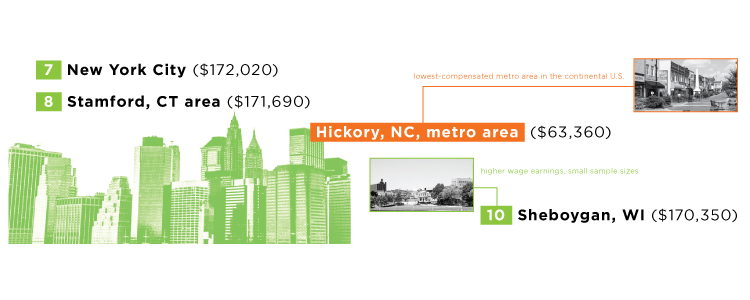
Photos by TylerFairbank/iStock/Getty Images Plus, franckreporter/iStock/Getty Images Plus, MoreISO/iStock/Getty Images Plus, Marko Horvat/iStock/Getty Images Plus, pawel.gaul/iStock/Getty Images Plus, DenisTangneyJr/iStock/Getty Images Plus, Shutterstock
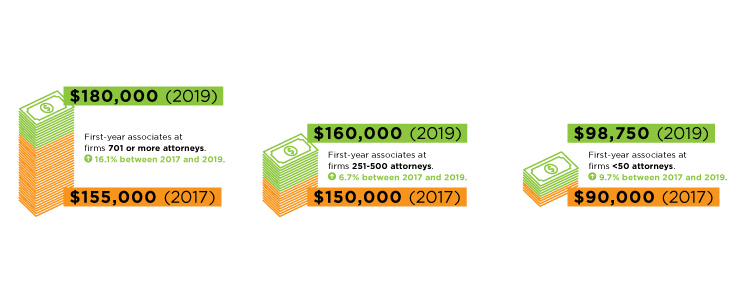
Illustrations by PeterSnow/iStock/Getty Images Plus
Starting in 2019, some big firms began offering $190,000 starting salaries to first-years, but this trend is, so far, concentrated in areas like Dallas, Houston, Los Angeles, New York City, San Francisco and Washington, D.C., according to NALP.
Looking past regional differences, Martindale-Avvo’s 2019 Attorney Compensation Report, which took a survey of 7,800 solo and small-firm attorneys, found substantial gaps based on gender, client type and practice area.
Collecting compensation data (wages plus bonuses and profit-sharing) from solo attorneys and attorneys at firms with less than 22 lawyers, Martindale found women made 36% less than their male counterparts—a potential difference of $79,000 a year. While the gap shrank slightly between 2017 and 2018, data previously unpublished by the company shows that women earn less than men at every point of their career.
The report notes that women were more likely to represent consumers than corporations in 2018. Representing consumers earns about 28% less than representing corporations, regardless of gender.
At the opposite end of the law firm scale, the 2018 survey by Major, Lindsey & Africa found that since 2010, their results have shown male partners making 32% to 53% more than their female counterparts.
The 2018 report, however, includes a statistical analysis of the data that indicated “gender does not have a statistically significant impact on compensation” and instead attributes the gap to hourly rate and originations (the creation of new clients or business).
Claudia Goldin, an economist at Harvard University who studies the gender pay gap, says that there are many issues that can lead to women making less than men, “but it’s pretty clear that the proximate cause of the biggest differences that we see has to do with: women are on call at home, and men are on call in the office.”
In other words, because women are expected to be at home more than men, it affects their ability to bring in business and clients.
There were also notable swings in earnings based on practice area, according to Martindale. In 2018, bankruptcy, immigration and probate attorneys made, on average, $140,000 or less. At the same time, medical malpractice and personal injury attorneys made over $250,000.
Outside of the for-profit legal market, public lawyers—defenders, prosecutors, legal aid and nonprofit attorneys—are making significantly less money.
While these wages have largely kept up with or done slightly better than inflation over the past decade, the median salary for a first-year public attorney is between $48,000 and $58,300, according to a 2018 report by NALP that was republished by the ABA.
While the gamut of attorney wages is wide, greater societal context is important. According to BLS, the annual mean wage for all occupations was $51,960. So, saying that lawyers’ salaries create winners and losers is hard, says Lindsey at Major, Lindsey & Africa.
“Even lawyers making the least among lawyers are still making more than most people,” he says.

Photos by OSTILL/iStock/Getty Images Plus; Illustrations by PeterSnow/iStock/Getty Images Plus, GreenTana/iStock/Getty Images Plus
See the other stories in this package:
Inside the Legal Profession: What the industry looks like in 2019



